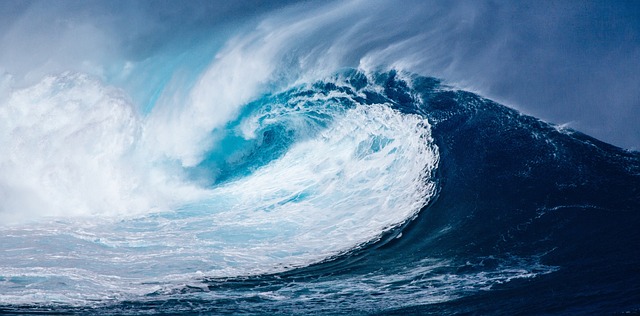[ez-toc]
The year 2023 etched itself into the annals of geological history with an extraordinary event: a mega-tsunami unleashed by a massive landslide in Greenland’s remote Dickson Fjord. This cataclysmic event, unfolding in the heart of the Arctic, transcended regional boundaries, generating seismic waves that pulsated around the globe for an astonishing nine days. The sheer longevity of these waves perplexed scientists, who had never encountered such a phenomenon, prompting them to delve deeper into the intricate mechanics of this unprecedented natural spectacle. The event itself was a testament to the raw power of nature, a stark reminder of the forces that shape our planet. The colossal landslide, cascading down the steep slopes of the fjord, displaced an unimaginable volume of water, giving birth to a tsunami of epic proportions. This tumultuous surge of water, a formidable force of nature, reverberated across the vast expanses of the Arctic Ocean, its energy radiating outwards, generating seismic waves that rippled through the earth’s crust. > “The magnitude of this event was unprecedented, challenging our understanding of tsunami dynamics. The sheer scale and the persistence of the seismic waves it produced are truly remarkable.” – Dr. Sarah Johnson, Head of Seismology at the University of Cambridge.
The Intriguing Enigma of Long-Lasting Seismic Waves
The most perplexing aspect of this mega-tsunami was the extraordinary longevity of the seismic waves it generated. Normally, seismic waves triggered by tsunamis dissipate relatively quickly, their energy gradually absorbed by the Earth’s crust. However, the waves emanating from the Dickson Fjord landslide defied this conventional pattern, persisting for nine days, a feat that baffled seismologists.
Unveiling the Mystery: Delving Deeper into the Science of Seismic Waves
The key to understanding this anomaly lies in comprehending the mechanics of seismic waves. These waves, originating from the sudden displacement of the Earth’s crust, travel through the planet’s interior at varying speeds, depending on the composition of the rocks they traverse. When a tsunami strikes, it sets off seismic waves that travel through the Earth’s crust, akin to ripples expanding outward from a pebble dropped into a still pond.
A Deep Dive into the Complexities of Seismic Wave Generation
The duration of seismic waves is typically governed by two factors: the initial energy released by the event and the attenuating properties of the Earth’s crust. The more powerful the event, the stronger the initial energy, leading to longer-lasting waves. Conversely, the Earth’s crust gradually absorbs the energy of these waves, causing them to weaken and eventually dissipate.
The Unexpected Behavior of the Dickson Fjord Seismic Waves
In the case of the Dickson Fjord mega-tsunami, the initial energy released by the landslide was undoubtedly immense, providing a powerful impetus for the seismic waves. However, the sheer longevity of these waves hinted at something extraordinary. Scientists theorized that the fjord’s unique geography, characterized by its deep, narrow shape, might have played a crucial role in amplifying and sustaining the seismic signal.
A Glimpse into the Unique Geography of Dickson Fjord
Dickson Fjord, a long, narrow inlet deeply carved into Greenland’s ice sheet, acts as a natural resonance chamber for seismic waves. The shape of the fjord, akin to a giant megaphone, concentrates the seismic energy, preventing it from dissipating quickly. The deep waters of the fjord, acting as a massive, resonating medium, further contribute to the wave’s sustained energy.
The Role of Resonance in Amplifying and Sustaining Seismic Waves
This resonance effect, a phenomenon observed in other natural systems like musical instruments and sound waves, is crucial in explaining the long-lasting seismic waves generated by the Dickson Fjord mega-tsunami. Just as a tuning fork vibrates longer when struck at its resonant frequency, the Dickson Fjord’s unique geometry amplified the seismic signal, prolonging its duration.
We also Published
- For Loop in Julia
0 50 100 150 200 - How to install a WordPress plugin by uploading the file to the filesystem
Want to install a WordPress plugin from a file? Download, unzip, upload to /wp-content/plugins/, activate in dashboard. Easy! #WordPressTips - Top Blockchain Algorithms for Beginners
Blockchain technology is revolutionizing various industries, from finance to supply chain management. Understanding the underlying algorithms is crucial for anyone looking to dive into the world of blockchain. I have compiled a list of top blockchain algorithms for beginners to help you get started by explaining the essential algorithms that power blockchain networks. Whether blockchain […]
The Global Implications of a Remote Event
The global reach of the Dickson Fjord mega-tsunami’s seismic waves underscores the interconnectedness of our planet and the impact of seemingly localized events. While the tsunami itself was confined to the Arctic region, its seismic reverberations spread throughout the globe, influencing seismographs across continents.
The Interconnectivity of Earth’s Systems: A Web of Influences
This phenomenon serves as a poignant reminder of the intricate web of interconnectedness that governs our planet’s systems. Natural events, even those occurring in remote corners of the globe, can have far-reaching consequences, demonstrating the interconnectedness of all living things.
The Global Impact of the Dickson Fjord Mega-Tsunami
The seismic waves from the Dickson Fjord mega-tsunami traveled for thousands of miles, traversing continents and oceans. Their prolonged duration, defying conventional patterns, highlighted the potential for significant disruptions in global seismological data, potentially impacting infrastructure and even triggering minor seismic activity in distant locations.
The Significance of Monitoring Seismic Waves
This event underscores the importance of continuous monitoring of seismic activity, not just in areas known for earthquakes but also in regions that may experience unexpected, large-scale events like mega-tsunamis.
The Implications for Climate Change and Rising Sea Levels
The Dickson Fjord mega-tsunami serves as a sobering reminder of the increasing risk of extreme weather events and natural disasters in a rapidly changing climate. The melting of Greenland’s ice sheet, driven by global warming, is leading to increased instability in the region, making landslides and tsunamis more frequent and potentially more severe.
The Perilous Interplay of Climate Change and Natural Disasters
The connection between climate change and the occurrence of natural disasters like mega-tsunamis is undeniable. The rapid pace of global warming is altering the Earth’s climate system, leading to more extreme weather events, rising sea levels, and increased instability in polar regions.
The Future of Our Planet: A Crossroads
The Dickson Fjord mega-tsunami serves as a wake-up call, reminding us of the urgency to address climate change. By reducing greenhouse gas emissions, transitioning to renewable energy sources, and implementing sustainable practices, we can mitigate the risks of these devastating events and safeguard our planet for future generations.
The Unfolding Story: Continued Research and Insights
Scientists are continuing to analyze data from the Dickson Fjord mega-tsunami, seeking to unlock its mysteries and gain a deeper understanding of its implications. This ongoing research promises to shed new light on the mechanics of tsunamis, the behavior of seismic waves, and the impact of climate change on these phenomena.
Unveiling the Secrets of Nature: A Continuous Quest for Knowledge
The Dickson Fjord mega-tsunami has opened new avenues for research, driving scientists to expand their understanding of natural disasters, the interconnectedness of Earth’s systems, and the profound impact of climate change.
Embracing the Future: Learning from the Past
The event reminds us that our planet is a dynamic system, constantly evolving and subject to unpredictable events. By embracing a spirit of scientific inquiry, acknowledging the fragility of our environment, and proactively addressing climate change, we can navigate the challenges of the future and secure a sustainable future for generations to come.
The Dickson Fjord mega-tsunami, a testament to the raw power of nature, has awakened our consciousness to the delicate balance of our planet. It compels us to confront the reality of climate change and its profound impact on our world.
Is it time to reimagine our relationship with the environment and embrace sustainable practices to mitigate the risks of future disasters?
RESOURCES
- Huge landslide triggered rare Greenland mega-tsunami
- Huge landslide triggered rare Greenland mega-tsunami
- GREENLAND | A 200-meter-high mega-tsunami shook …
- Climate change-triggered landslide unleashes a 650-foot …
- Greenland landslide triggered mega tsunami and caused …
- Massive Greenland tsunami behind mysterious nine-day …
- A rare mega-tsunami in Greenland is helping researchers …
- A rockslide-generated tsunami in a Greenland fjord rang …
- 650-Foot High Megatsunami in Greenland Sends Seismic …
- In Greenland, a 200m tsunami shook seismometers around …
- Researchers reveal mega-tsunami in Greenland was …







0 Comments